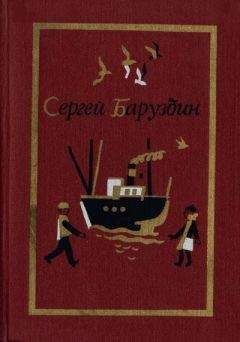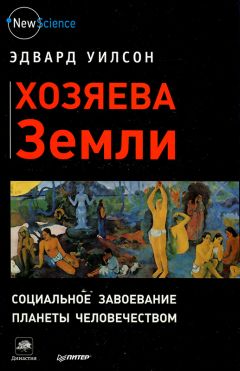Эдвард Уилсон - Хозяева Земли
ГЛАВА 12. ПОЯВЛЕНИЕ ЭУСОЦИАЛЬНОСТИ
Обилие общественных насекомых в амазонском лесу. Н. J. Fittkau and Н. Klinge, «On biomass and trophic structure of the central Amazonian rainforest ecosystem» Biotropica 5: 2-14 (1973).
ГЛАВА 13. ПРИЧИНЫ УСПЕХА ОБЩЕСТВЕННЫХ НАСЕКОМЫХ
Муравьи-кочевники и их подопечные. U. Maschwitz, М. D. Dill, and J. Williams, «Herdsmen ants and their mealybug partners» Abhandlungen der Senckenbergischen Naturforschenden Gesellschaft Frankfurt am Main 557:1-373 (2002).
ГЛАВА 14. НАУЧНАЯ ЗАГАДКА РЕДКОСТИ ОБЩЕСТВЕННОГО ОБРАЗА ЖИЗНИ Эволюционные истоки эусоциальности. Edward О. Wilson and Bert Holldobler, «Eusociality: Origin and consequences» Proceedings of the National Academy of Sciences, U.S.A. 102(38): 13367-13371 (2005); Charles D. Michener, The Bees of the World (Baltimore: Johns Hopkins University Press, 2007); Bryan N. Danforth, «Evolution of sociality in a primitively eusocial lineage of bees» Proceedings of the National Academy of Sciences, U.SA. 99(1): 286-290 (2002): Bert Holldobler and Edward 0. Wilson, The Superorganism: The Beauty, Elegance, and Strangeness of Insect Societies (New York: W. W. Norton, 2009).
Эусоцивльностьу раков-щелкунов.). Emmett Duffy, С. L. Morrison, and R.Rios, «Multiple origins of eusociality among sponge-dwelling shrimps (Synalpheus)» Evolution 54(2): 503-516 (2000).
Уникальные эволюционные события. Geerat j. Vermeij, «Historical contingency and the purported uniqueness of evolutionary innovations» Proceedings of the National Academy of Sciences, U.S.A. 103(6): 1804-1809 (2006).
Помощники по уходу за птенцами. В. J. Hatchwell and ]. Komdeur, «Ecological constraints, life history traits and the evolution of cooperative breeding» Animal Behaviour 59(6): 1079-1086 (2000).
ГЛАВА 15. АЛЬТРУИЗМ И ЭУСОЦИАЛЬНОСТЬ НАСЕКОМЫХ НАХОДИТ ОБЪЯСНЕНИЕ
Происхонщение обществ насекомых. William Morton Wheeler, Colony Founding among Ants, with an Account of Some Primitive Australian Species (Cambridge, MA: Harvard University Press, 1933); Charles D. Michener, «The evolution of social behavior in bees» Proceedings of the Tenth International Congress in Entomology, Montreal 2: 441-447 (1956); Howard E. Evans, «The evolution of social life in wasps» Proceedings of the Tenth International Congress in Entomology, Montreal, 2: 449-457 (1956).
Альтернатива теории родственного отбора. Martin A. Nowak, Corina E. Tarnita, and Edward 0. Wilson, «The evolution of eusociality» Nature 466:1057-1062 (2010). Более свежая сводка содержится в работе: Martin A. Nowak and Roger Highfield in SuperCooperators: Altruisim, Evolution, and Why We Need Each Other to Succeed (New York: Free Press, 2011).
Шаги на пути к эусоциальности у насекомых. Edward О. Wilson, «One giant leap: How insects achieved altruism and colonial life» BioScience 58:17-25 (2008).
Природные ресурсы и ранние этапы эусоциальности у насекомых. Edward О. Wilson and Bert Holldobler, «Eusociality: Origin and consequences» Proceedings of the National Academy of Sciences, U.S.A. 102(38): 13367-13371 (2005).
Одиночные Hymenoptera. James T. Costa, The Other Insect Societies (Cambridge, MA: Belknap Press of Harvard University Press, 2006).
Эусоциальные жуки. D. S. Kent and ). A. Simpson, «Eusociality in the beetle Austroplatypus incompertus (Coleoptera: Curculionidae)» Naturwissenschaften 79: B6-87 (1992).
Эусоциальные трипсы и тли. Bernard ]. Crespi, «Eusociality in Australian gall thrips» Nature 359:724-726 (1992); David L. Stern and W. A. Foster, «The evolution of soldiers in aphids» Biological Reviews of the Cambridge Philosophical Society 71: 27-79 (1996).
Эусоциальные раки-щелкуны. J. Emmett Duffy, «Ecology and evolution of eusociality in sponge-dwelling shrimp» in J. Emmett Duffy and Martin Thiel, eds., Evolutionary Ecology of Social and Sexual Systems: Crustaceans as Model Organisms (New York: Oxford University Press, 2007).
Общественные колонии пчел, полученные в экспериментальных условиях. Shoichi F. Sakagami and Yasuo Maeta, «Sociality, induced and/or natural, in the basically solitary small carpenter bees (Ceraf/nc)» в книге Yosiaki Ito, jerram L. Brown, and Jiro Kikkawa, eds., Animal Societies: Theories and Facts (Tokyo: Japan Scientific Societies Press, 1987), pp. 1-16; William T. Wcislo, «Social Interactions
and behavioral context in a largely solitary bee, Lasioglossum (Dialictus) figueresi (Hymenoptera, Halictidae)» Insectes Sociaux 44:199-208 (1997); Raphael Jeanson, Penny F. Kukuk, and Jennifer H. Fewell, «Emergence of division of labour in halictine bees: Contributions of social interactions and behavioural variance» Animal Behaviour 70:1183-1193 (2005).
Модель фиксированного порога при разделении труда у насекомых. Gene Е. Robinson and Robert Е. Page Jr., «Genetic basis for division of labor in an insect society» in Michael D. Breed and Robert E. Page Jr., eds., The Genetics of Social Evolution (Boulder, CO: Westview Press 1989), pp. 61-80; E. Bonabeau, G. Theraulaz, and Jean-Luc Deneubourg, «Quantitative study of the fixed threshold model for the regulation of division of labour in insect societies» Proceedings of the Royal Society В 263: 1565-1369 (1996); Samuel N. Beshers and Jennifer H. Fewell, «Models of division of labor in social insects» Annual Review of Entomology 46:413-440 (2001).
ГЛАВА 16. ГИГАНТСКИЙ СКАЧОК ДЛЯ ВСЕХ НАСЕКОМЫХ
Ценность защиты гнезда. J. Field and S. Brace, «Pre-social benefits of extended parental care» Nature 427: 650-652 (2004).
Возникновение и исчезновение эусоциальности в эволюции пчел. Bryan N. Danforth, «Evolution of sociality in a primitively eusocial lineage of bees» Proceedings of the National Academy of Sciences, U.S.A. 99(1): 286-290 (2002).
Сезонные изменения способствуют общественному поведению. James Н. Hunt and Gro V. Amdam, «Bivoltinism as an antecedent to eusociality in the paper wasp genus Polistes» Science 308: 264-267 (2005).
Происхождение бескрылых рабочих у муравьев. Ehab Abouheif and G. A. Wray, «Evolution of the gene network underlying wing polyphenism in ants» Science 297: 249-252 (2002).
Происхождение полигинии у огненных муравьев. Kenneth G. Ross and Laurent Keller, «Genetic control of social organization in an ant» Proceedings of the National Academy of Sciences, U.S.A. 95(24): 14232-14237 (1998).
Гены и зусоциальное поведение у огненных муравьев. М. J. В. Krieger and Kenneth G. Ross, «Identification ofa major gene regulating complex social behavior» Science 295: 328 332 (2002).
Генетика и развитие общественных пчел. James Н. Hunt and Gro V. Amdam, «Bivoltinism as an antecedent to eusociality in the paper wasp genus Polistes» Science 308: 264-267 (2005).
Сотрудничество у одиночных пчел. Shoichi F. Sakagami and Yasuo Maeta, «Sociality, induced and/or natural, in the basically solitary small carpenter bees (1Ceratina)» in Yosiaki Ito, Jerram L. Brown, and Jiro Kikkawa, eds.. Animal Societies: Theories and Facts (Tokyo: Japan Scientific Societies Press, 1987), pp. 1-16.
Сотрудничающие царицы у примитивных зусоциальных пчел. Miriam Н. Richards, Eric J. von Wettberg, and Amy C. Rutgers, «А novel social polymorphism in a primitively eusocial bee» Proceedings of the Notional Acodemy of Sciences, U.S.A. 100(12): 7175-7180 (2003).
Изменение последовательности плана развития приводит к эусоциальности.
Gro V. Amdam et al., «Complex social behaviour from maternal reproductive traits» Nature 439: 76-78 (2006); Gro V. Amdam et al., «Variation in endocrine signaling underlies variation in social lifehistory» American Naturalist 170: 37-46 (2007).
Точка невозврата в эволюции эусоциальности. Edward О. Wilson, The Insect Societies (Cambridge, MA: Belknap Press of Harvard University Press, 1971); Edward 0. Wilson and Bert Holldobler, «Eusociality: Origin and consequence» Proceedings of the National Academy of Sciences, U.S.A. 102(38): 13367 13371 (2005).
ГЛАВА 17. ОБЩЕСТВЕННЫЕ ИНСТИНКТЫ КАК ПРОДУКТ ЕСТЕСТВЕННОГО ОТБОРА
Дарвин об инстинктах как генетических адаптациях. Четыре основополагающих работы Дарвина: упомянутая мной «Выражение эмоций у человека и животных» (1873), «Путешествие натуралиста вокруг света на корабле „Бигль"» (1838), «Происхождение видов» (1859) и «Происхождение человека» (1872).
ГЛАВА 18. ДВИЖУЩИЕ СИЛЫ ОБЩЕСТВЕННОЙ ЭВОЛЮЦИИ
Гамильтон о родственном отборе. William D. Hamilton, «The genetical evolution of social behaviour, I, II» journal of Theoretical Biology 7:1-52 (1964).
Холдейн и его формулировка родственного отбора. J. В. S. Haldane. «Population genetics» New Biology (Penguin Books) 18: 34-51 (1955).
Крах гаплодиплоидной гипотезы. Edward 0. Wilson, «One giant leap: How insects achieved altruism and colonial life» BioScience 58(1): 17-25 (2008).
Преимущества высокого генетического разнообразия в колониях муравьев. Blaine Cole and Diane C. Wiernacz, «The selective advantage of low relatedness» Science 285: 891-893 (1999); William О. H. Hughes and J. I. Boomsma, «Genetic diversity and disease resistance in leaf-cutting ant societies» Evolution 58:1251-1260 (2004).
Генетически разнообразные касты муравьев. F. Е. Rheindt, С. Р. Strehl, and Jurgen Gadau, «А genetic component in the determination of worker polymorphism in the Fiorida harvester ant Pogonomyrmex badius»Insectes Sociaux 52:163-168 (2005).
Климат-контроль в гнездах общественных насекомых.). С. Jones, М. R. Myerscough, S. Graham, and Ben P. Oldroyd, «Honey bee nest thermoregulation: Diversity supports stability» Science 305:402-404 (2004).
Генетические факторы разделения труда в колониях муравьев. Т. Schwander, Н. Rosset, and М. Chapuisat, «Division of labour and worker size polymorphism in ant colonies: The impact of social and genetic factors» Behavioral Ecology and Sociobiology 59: 215-221 (2005).
Теория многоуровневого отбора обязана своим происхождением многим источникам, но основной толчок ее развитию дали приведенные ниже статьи с участием автора этой книги. Edward О. Wilson, «Kin selection as the key to altruism: Its rise and fall» Social Research 72(1): 159-166 (2005): Edward 0. Wilson and Bert Holldobler, «Eusociality: Origin and consequences» Proceedings of the National Academy of Sciences, U.S.A. 102(38): 13367-13371 (2005); David Sloan Wilson and Edward 0. Wilson, «Rethinking the theoretical foundation of sociobiology» Quarterly Review of Biology 82(4): 327-348 (2007); Edward 0. Wilson, «One giant leap: How insects achieved altruism and colonial life» BioScience 58(1): 17-25 (2008); David Sloan Wilson and Edward 0. Wilson, «Evolution ‘for the good of the group,'» American Scientist 96: 380-389 (2008); и, наконец, обобщающая работа: Martin A. Nowak, Corina E. Tarnita and Edward 0. Wilson, «The evolution of eusociality» Nature 466: 1057-1062 (2010). Последняя из приведенных статей и легла в основу этой главы.


